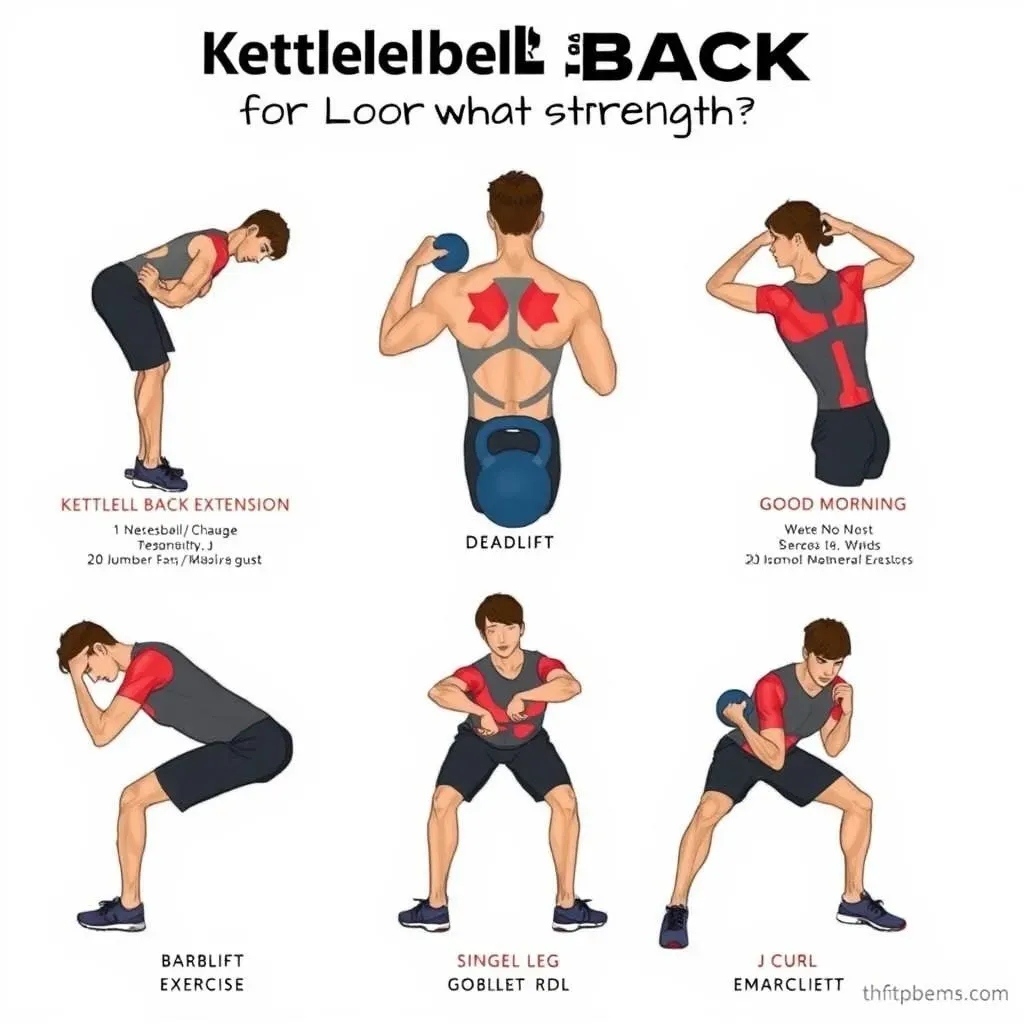Table of Contents
Ever felt that nagging ache in your lower back? It's like a grumpy houseguest that just won't leave. Well, what if I told you that a simple kettlebell could be your secret weapon to evict that pain and build a back that's stronger than a superhero's? That's right, a targeted kettlebell workout for lower back can be a total game-changer. Forget about those complicated machines and endless stretches. We're talking about functional, real-world strength that you can build with just one piece of equipment. In this article, we're not just going to throw random exercises at you. We'll explore the fantastic benefits of using kettlebells to strengthen your lower back, and then we'll show you the six best exercises that'll work wonders. We’ll also look at how to do them right, because bad form is no one's friend, and finally, we'll hook you up with a sample 4-week workout to get you started. So, if you’re ready to say goodbye to back pain and hello to a stronger, more resilient you, let’s get started!
Benefits of Training the Lower Back With Kettlebells

Benefits of Training the Lower Back With Kettlebells
More Than Just a Strong Back
Let's be real, a lot of us think of the lower back as that annoying part of our body that just likes to hurt. But what if I told you it's actually a powerhouse? Training it with kettlebells isn't just about making your back look good; it's about building a foundation for everything else you do. Think about it: you use your lower back for almost every movement, from picking up groceries to playing sports. A strong lower back means better posture, less pain, and the ability to move through life with more ease. It's like building a solid base for a skyscraper – everything else rests on it.
And it's not just for athletes or gym rats. If you're someone who spends a lot of time sitting, strengthening your lower back is even more crucial. It helps counteract the effects of slouching and being hunched over a computer all day. Kettlebell exercises can improve your core stability, making you more resilient to injury. Plus, they engage multiple muscle groups at once, making them super efficient. So, you’re not just working your back but also your abs, glutes, and even your legs, all at the same time. It’s like a full-body workout with just one tool.
Real-World Advantages
Now, let’s get practical. How does a stronger lower back translate to everyday life? Well, imagine you're carrying heavy boxes up the stairs. A weak lower back might leave you feeling strained and sore, but a strong back makes the task feel less like a chore and more like a normal part of your day. It's like having a built-in support system. And for those of you who love to hit the gym, a solid lower back is essential for maximizing your performance in other exercises, too. It acts as a stabilizer, allowing you to lift heavier weights and perform complex movements with better control.
And it's not just about lifting heavy things either. Even simple activities like gardening or playing with your kids can become more enjoyable when you have a strong and pain-free lower back. I remember when I first started incorporating kettlebells into my routine. I used to get that dull ache after just a few hours of yard work, but now, I can spend the whole afternoon digging and planting without any issues. It's made a huge difference in my day-to-day life, and I think it can do the same for you.
Benefit | Why It Matters |
|---|---|
Improved Posture | Reduces slouching, makes you stand taller |
Reduced Pain | Less back aches, better daily comfort |
Enhanced Stability | Improved balance and control |
Better Performance | More efficient movement, heavier lifting |
Injury Prevention | Stronger back, less chance of strain |
The 6 Best Lower Back Kettlebell Exercises

The 6 Best Lower Back Kettlebell Exercises
Alright, let's get to the good stuff – the exercises themselves. Now, I know you might be thinking, "Are kettlebells really that great for the lower back?" And my answer is a resounding YES! But it's not about just swinging the weight around wildly. It's about choosing the right moves and doing them correctly. So, here are six of my absolute favorite kettlebell exercises for building a strong and resilient lower back. These aren't just random movements; they're carefully selected to target the muscles that support your spine, improve your stability, and reduce pain. We're talking about movements like kettlebell back extensions, deadlifts, good mornings, J curls, single-leg RDLs, and goblet squats, each one bringing something unique to the table.
Each of these exercises targets different muscle groups in your lower back, including the multifidus, erector spinae, spinalis, and latissimus dorsi. It's like having a full team working together to keep your back strong and pain-free. And the best part? These moves aren't just for the gym; they translate to real-life activities. You'll find yourself moving with more confidence and less fear of tweaking your back. So, let's break them down one by one, shall we?
The Lineup of Lower Back Superstars
First up, we have the Kettlebell Back Extension. This one's great for targeting those deep muscles along your spine. It's like giving your back a gentle hug, strengthening the muscles that keep you upright. Then there's the Kettlebell Deadlift, the king of all back exercises. It's not just about lifting weight; it's about learning to hinge at your hips and engage your entire posterior chain. Next, we have the Kettlebell Good Morning. It's a bit like a bow, strengthening your hamstrings and lower back. It's a fantastic move to improve your hip hinge and overall back health. And let's not forget the Kettlebell J Curl, a unique move that works your lower back in a different way, focusing on rotation and stability.
We're not done yet! The Kettlebell Single-Leg RDL is next on our list, a balance booster and lower back strengthener all in one. It's about controlled movement and stability, forcing your back to work hard to keep you upright. And finally, we have the Kettlebell Goblet Squat. It might seem like a leg exercise, but holding the kettlebell in front of you engages your core and lower back, making it a great all-around move. So, there you have it, six awesome exercises that, when done correctly, can transform your lower back strength and overall well-being. But remember, these are just tools – it's how you use them that matters. So, let's get into the specifics of each one.
Exercise | Primary Focus | Why It's Great |
|---|---|---|
Kettlebell Back Extension | Deep spinal muscles | Strengthens back muscles, improves posture |
Kettlebell Deadlift | Posterior chain | Builds overall back strength, functional movement |
Kettlebell Good Morning | Hamstrings and lower back | Improves hip hinge, back stability |
Kettlebell J Curl | Rotational strength | Enhances core, lower back stability |
Kettlebell Single-Leg RDL | Balance and back | Improves stability, strengthens back |
Kettlebell Goblet Squat | Core and lower back | Engages core, strengthens back |
Proper Form and Technique for Lower Back Kettlebell Exercises

Proper Form and Technique for Lower Back Kettlebell Exercises
Why Form Matters
Okay, so you're excited to swing some kettlebells and build that rock-solid lower back. That's awesome! But before you go all in, let's talk about form. It's not just about looking good while you're working out; it's about keeping yourself safe and actually getting the benefits you're looking for. Poor form can lead to strains, sprains, and all kinds of unpleasantness. We're talking about your spine here, folks, so let's treat it with respect. Think of it like this: if you're building a house, you wouldn't just throw the bricks together, would you? You'd make sure each one is placed properly to create a strong structure. Same goes for kettlebell exercises. Proper technique is the foundation of a strong and healthy back.
It's easy to get caught up in trying to lift the heaviest weight possible, but trust me, it's way better to start lighter and nail the form first. It's like learning to play an instrument. You wouldn't start with a complex concerto, right? You'd learn the basics first, practice the scales, and gradually work your way up. Same with kettlebells. Focus on the movement, feel the muscles working, and don't rush. It’s about quality over quantity. And remember, you're not just training your back; you're training your body to move efficiently and safely, and that will pay off in all aspects of your life.
Key Elements of Proper Technique
So, what are some of the key things to keep in mind when you're doing kettlebell exercises for your lower back? First off, you’ve got to master the hip hinge. That means bending at your hips, not your lower back. Imagine you're trying to close a car door with your butt – that’s the kind of movement we’re aiming for. Keeping your back straight and your core engaged is also super important. Think about bracing your abs as if someone was about to punch you in the stomach. It might sound dramatic, but it helps protect your spine. And breathe! Don't hold your breath during the exercises. Exhale on the exertion, inhale on the way back to the start position.
Another critical point is to control the movement, especially when you're lowering the weight. Don't let gravity do all the work. It's like driving a car, you wouldn't just slam on the brakes, you'd slow down gradually. Same with kettlebell movements. Pay attention to how your body feels, and if something feels off, stop and reassess. Also, don’t be afraid to use a mirror or record yourself to check your form. Sometimes it's hard to feel what you're doing wrong, but seeing it can make a world of difference. And if you are unsure, consider consulting a certified trainer. It’s an investment in your well-being and will help you avoid any potential injuries. Remember, consistency and good form are the keys to unlocking the full benefits of these exercises.
Form Element | Why It's Important |
|---|---|
Hip Hinge | Protects lower back, engages glutes |
Straight Back | Prevents injury, maximizes muscle activation |
Core Engagement | Stabilizes spine, improves power transfer |
Controlled Movement | Avoids injury, builds strength |
Breathing | Provides stability, helps with movement |
Sample 4Week Kettlebell Workout for Lower Back Strength

Sample 4Week Kettlebell Workout for Lower Back Strength
Getting Started: Your 4-Week Plan
Alright, you've got the exercises down, you know the form, now it's time to put it all together. We're not just going to have you do a bunch of random stuff. We need a structured plan, and that's where this 4-week workout comes in. It’s designed to be progressive, meaning we're going to gradually increase the intensity and volume as you get stronger. Think of it like building a staircase, each week you're going up a step. This isn't about rushing; it's about consistent progress. It's about building a foundation that will last. This plan isn't set in stone, it's a guide. Feel free to adjust it based on how your body feels. If something feels too easy, bump it up a bit. If you need a rest day, take one. The key is to listen to your body and be consistent.
The workout is broken down into three days a week, with rest days in between to allow your muscles to recover and grow. This isn't a "go hard or go home" scenario, it's about smart training. And remember, it’s not just about the workout itself, it’s about the bigger picture. It’s about making a habit of taking care of your body and building a routine that you can sustain long-term. I've seen so many people get excited, go too hard, then burn out. Don't be that person. Be smart. Be consistent. And most importantly, enjoy the process.
The Weekly Breakdown
So, what does a typical week look like? Well, we're going to focus on those six key exercises we talked about, but we'll mix them up each workout to keep things fresh and target your muscles from different angles. Each workout will start with a quick warm-up, like some light cardio and dynamic stretching, followed by the strength training session, and then a cool-down with static stretches. It's not rocket science, but it's effective. For each exercise, we're going to aim for 3 sets of 8-12 reps, but again, listen to your body. If you need to start with less, that's fine. If you can do more with good form, go for it. It’s about finding that sweet spot where you are challenged, but not overwhelmed.
And don't think you have to be a gym rat to do this. You can do these workouts anywhere you can swing a kettlebell: at home, in your backyard, even in a park. All you need is the space and the motivation. And speaking of motivation, it's important to set some goals for yourself. Maybe you want to be able to deadlift your bodyweight, or perhaps you just want to be able to bend down to pick up your laundry without feeling like you're going to throw your back out. Whatever your goal is, write it down, keep it in mind, and celebrate your progress along the way. It's the small wins that keep you going.
Week | Focus | Intensity |
|---|---|---|
1 | Learning the moves | Light weight, perfect form |
2 | Building endurance | Moderate weight, more reps |
3 | Increasing strength | Increase weight |
4 | Testing limits | Challenge yourself, maintain good form |
Sample Workout Routine
Now, let's get to the nitty-gritty. Here’s a sample routine. Remember this is just a template, so feel free to tweak it to suit your needs and preferences. For each workout, make sure you warm up first before you start lifting. Don't just jump right into the heavy stuff. It’s like trying to start a car on a cold morning, you need to let it warm up first. And remember, rest is crucial. Don’t train your lower back every day. Give your body the time it needs to recover and rebuild. It’s during rest that the real magic happens. And finally, stay hydrated, eat well, and get enough sleep. All these things play a role in your overall progress and well-being.
Here’s a sample weekly schedule. Mondays, Wednesdays, and Fridays are your workout days. The rest of the week is for rest and recovery. For each workout day, mix up the exercises. For example, on Monday, you might focus on the deadlift, back extensions, and goblet squats. On Wednesday, you could do good mornings, J curls, and single-leg RDLs. And on Friday, you mix them all up. It’s all about keeping your body guessing and preventing boredom. So, there you have it, a sample 4-week workout plan to get you started on your journey to a stronger, more resilient lower back. It’s not a sprint, it’s a marathon, so be patient, be consistent, and enjoy the process.